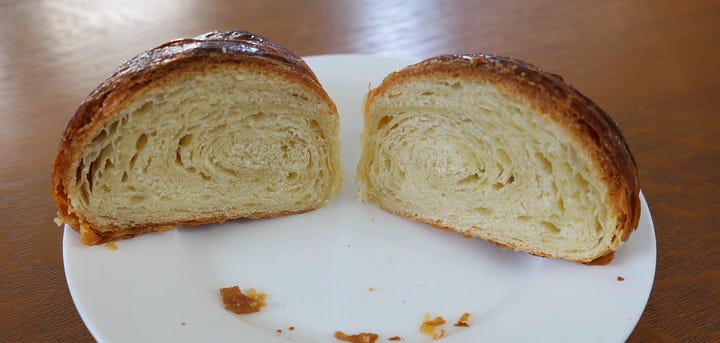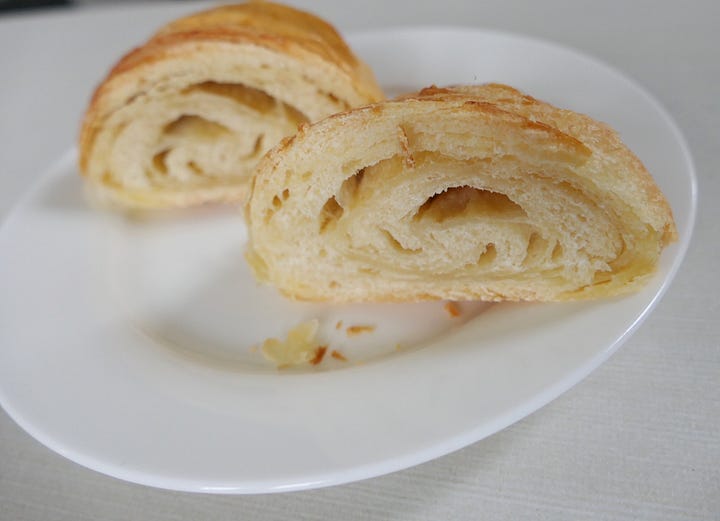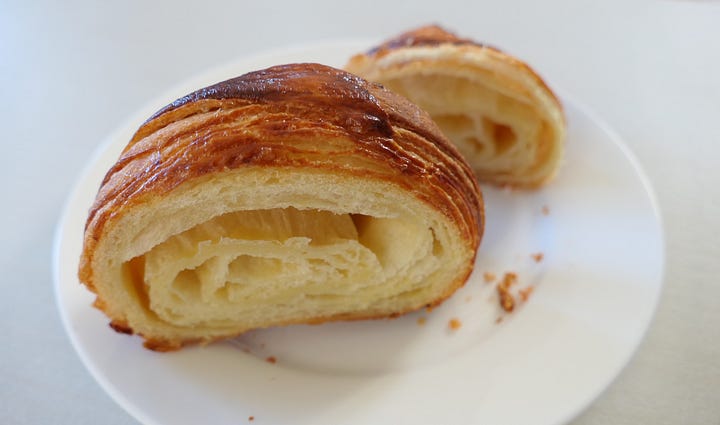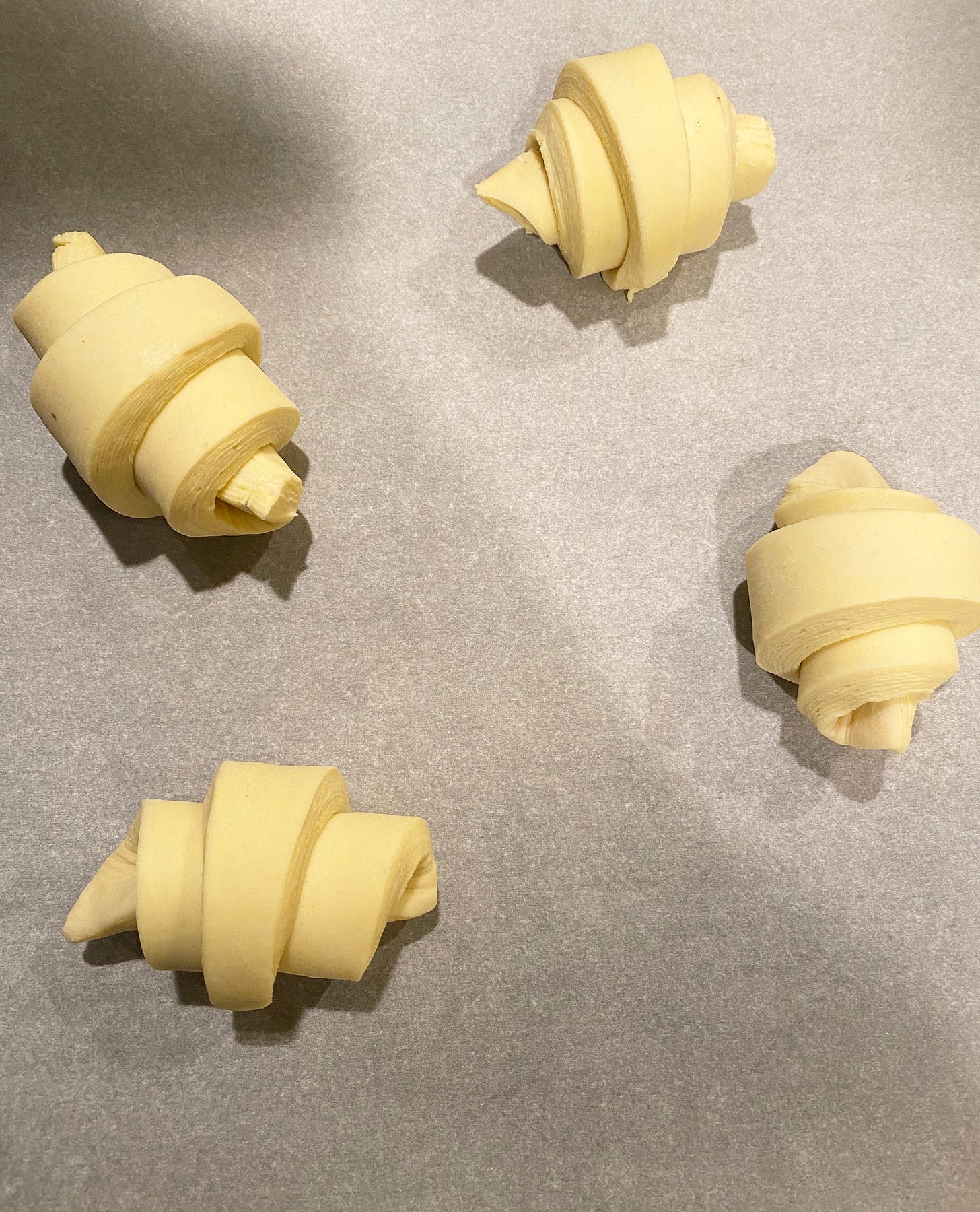8 lessons in capturing butter in sourdough croissants
From three recipes across the world
We have some decent bakeries in Portland, Oregon, but there is no comparison to a fresh croissant just minutes out of the oven. I couldn’t resist trying a couple new recipes from recent cookbook releases as well as an old favorite.
1. Bryan Ford’s Argentinian Medialunas from ‘Pan y Dulce’
Starter: Stiff sweet sourdough
Dough: mix of All Purpose and bread flour, enriched with egg
Bulk Fermentation: 28 hours
Lamination: 3 letter folds
Proof: 8-10 hours
According to Ford, Medialunas are common in cafes in Buenos Aires, but they definitely aren’t the same as the European croissant. The dough is enriched, and the pastries are proofed and baked tightly together to get pull-apart soft interiors with flaky layers on top.
Working with this higher hydration dough was a dream to easily laminate, creating thin layers of butter by rolling out and folding the dough. The recipe did not have information on dimensions so I may not have had the proper size and shape. It still turned out great, though, with shiny layers highlighted with an orange zest sugar syrup. They were very sweet and almost cake-like inside—perfect to accompany a cup of coffee.
Lessons learned:
Bake in the highest rack on your oven to avoid overbrowning the bottom of the pastry.
Your kitchen ambient temperature should be between 65-70°F to make sure the butter doesn’t ooze out of the dough when laminating.


2. Grego Montalban Sanchez’s Classic Croissants from ‘Bring Home the Bakery’
Starter: Stiff sweet sourdough
Dough: Bread flour, enriched with egg and milk
Bulk Fermentation: 18 hours
Lamination: 3 letter folds
Proof: 21 hours
Sanchez has a micro-bakery in Australia and uses one type of sourdough pastry dough to make a diverse variety of pastries: croissants, palmeras, torsades, and escargots.
This was the longest wait to make fresh croissants. There were some good layers, but it did not get a beautiful brown color despite increasing bake time. This recipe had the most sugar by percentage, but flavor was still balanced likely because of the long fermentation time.
Lessons learned:
Use a stiff sweet sourdough starter instead of liquid sourdough to avoid developing sour flavors with long fermentation times.
Use the convection bake setting on your oven to ensure croissants rise and bake evenly.
Monitor your croissants closely to ensure that they don’t overproof. They should be jiggly, but still firm to the touch.


3. Melissa Weller’s Classic Croissants from ‘A Good Bake’
Starter: Liquid sourdough
Dough: mix of bread flour and whole wheat pastry flour, instant yeast
Bulk Fermentation: 8-12 hours
Lamination: 1 book fold, 1 letter fold
Proof: 2.5-3 hours
As a professional baker in the United States, Weller put a lot of trial-and-error into making perfect-looking croissants at home. She found that adding a little butter to the dough helped make it easier to do the lamination steps without a commercial laminator.
This has been my favorite recipe that I’ve made many times, and it still is! Not only is it efficient with the least amount of waiting time and lamination steps, but the result is absolutely beautiful. The croissants are nice and flaky with a moist, light interior.
Lessons learned:
Save any plastic wrap to reuse throughout the recipe and reduce waste.
Cover the croissants with a damp kitchen towel during proofing to prevent the dough from forming a skin.
Any dough pieces trimmed during lamination can be rolled in sugar, placed in a muffin tin, proofed, and baked at 350°F until golden brown. Bonus pastry!


It was interesting to see the outcome of pastry based on variables of sourdough starter, flour type, dough enrichment, amount of sugar/flour, and time for fermentation and lamination. Although each croissant was unique, they all captured the magical contrast: light, dark, tender, and flaky.


Oh my goodness, those Melissa Weller croissants! This is so inspiring!
A Good Bake is one of my favorite baking cookbooks!